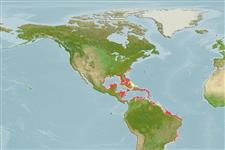Environment: milieu / climate zone / depth range / distribution range
экология
морской ассоциированный с рифами. Tropical
Southwestern Atlantic: Belize, Central America, and Puerto Rico; Caribbean, to
Santa Catarina State, southern Brazil.
Size / Вес / Возраст
Maturity: Lm ? range ? - ? cm
Max length : 8.2 cm TL самец/пол неопределен; (Ref. 13628)
колючие лучи спинного плавника (общее число) : 20; членистые (мягкие) лучи спинного плавника (общее число) : 9 - 11; колючие лучи анального плавника: 2; членистые (мягкие) лучи анального плавника: 7 - 21. This species is distinguished from its southwestern Atlantic congeners by the following set of characters: D XX,9-11 (rarely XIX or XXI); A II,17-21; pectoral-fin rays14-15 (rarely 13); length of third pelvic-fin ray contained 2.5 to 3.0 times in second pelvic-fin ray; lateral-line scales 48-56; total nuchal cirri 24-36; pectoral-fin base and midline before dorsal-fin no scales; breast usually fully scaled in males, often naked in females; pores 2-3 from preopercular canal onto opercle. Colouration: pattern dominated by 5-6 (rarely 7), saddle-like bars on body, extending to spiny dorsal fin (Ref. 123106).
Occurs in shallo reefs (Ref. 123106), on sandy bottoms and Thalassia testudinum beds (Ref. 13628). Feeds mainly on crustaceans but also on gastropods and worms (Ref. 13628).
Life cycle and mating behavior
Maturities | размножение | Spawnings | Egg(s) | Fecundities | личинки
Carvalho-Filho, A., I. Sazima, S.M.Q. Lima, D. Almeida, L. Mendes, R.M. Dias, M.R. Britto and J.L. Gasparini, 2020. Review of the genus Malacoctenus (Actinopterygii: Labrisomidae) from the Southwestern Atlantic, with description of two new species. Zootaxa 4819(3):499-520. (Ref. 123106)
Статус Красного Списка МСОП (Ref. 130435)
Угроза для людей
Harmless
Использование человеком
дополнительная информация
инструменты
Специальные отчеты
Скачать в формате XML
ресурсы в Интернет
Estimates based on models
Preferred temperature (Ref.
123201): 24.1 - 28.1, mean 27.3 °C (based on 722 cells).
Phylogenetic diversity index (Ref.
82804): PD
50 = 0.5000 [Uniqueness, from 0.5 = low to 2.0 = high].
Bayesian length-weight: a=0.00603 (0.00294 - 0.01235), b=3.08 (2.89 - 3.27), in cm total length, based on LWR estimates for this species & (Sub)family-body (Ref.
93245).
Trophic level (Ref.
69278): 3.4 ±0.49 se; based on food items.
устойчивость к внешним воздействиям (Ref.
120179): средний (среднего размера), минимальное время удвоения популяции 1.4-4.4 года (Fec = 4,000).
Fishing Vulnerability (Ref.
59153): Low vulnerability (10 of 100).
Nutrients (Ref.
124155): Calcium = 146 [72, 238] mg/100g; Iron = 0.757 [0.435, 1.292] mg/100g; Protein = 18.2 [17.1, 19.3] %; Omega3 = 0.0978 [, ] g/100g; Selenium = 22.2 [9.4, 48.7] μg/100g; VitaminA = 181 [57, 582] μg/100g; Zinc = 2.25 [1.47, 3.24] mg/100g (wet weight);
